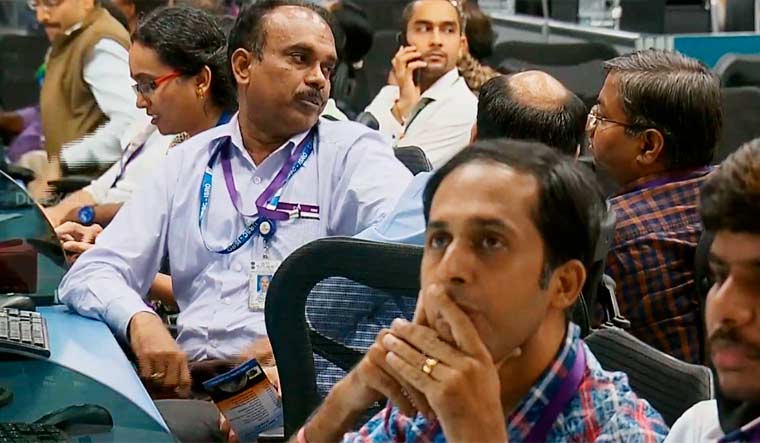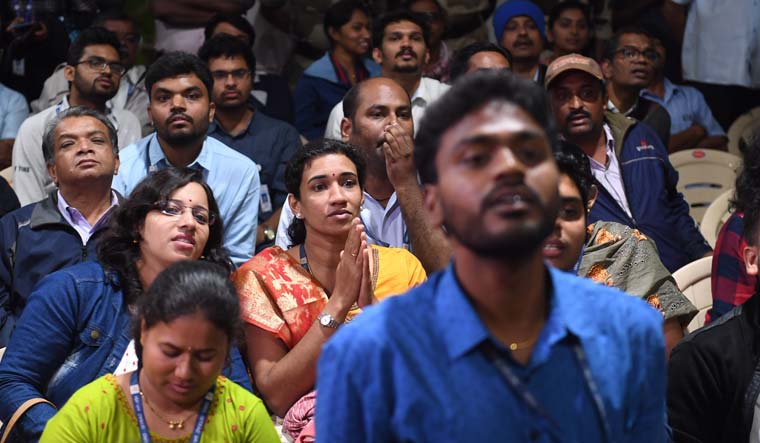37 per cent. Those were the odds that ISRO chairman K. Sivan had said the success rate of landing on the moon would be.
Until the early morning that ISRO had attempted to make history with the world’s first moon landing near the lunar South Pole, only 20 out of 32 missions to soft-land a spacecraft on to the moon had succeeded.
Now, as the news trickles in, that number is still just 20, but out of 33 attempts this time. After back-to-back successes, ISRO may have, like so many other space agencies in the world, tasted failure.
After 48 days, the mission to soft-land has reached a premature end. The GSLV-Mk3 had launched successfully, the rocket escaped earth’s velocity and entered the moon’s orbit on schedule, the lander separated from the orbiter on September 2, and Vikram began its descent towards the moon’s surface on September 7.
Vikram began its powered descent dot on time at 1:40am, as Prime Minister Narendra Modi and an anxious nation stayed up late to watch history unfold. From an altitude of 30km, Vikram was supposed to take 15 minutes to reach the surface. ISRO’s chairman had earlier dubbed this the ‘15 minutes of terror’, as they were the most crucial and sensitive phase of the three-stage mission.
Vikram’s orbital velocity had to go down from 1,640 m/s to 0 m/s so the spacecraft can safely land on the moon. The first 12 minutes went by flawlessly, as the lander reduced its speed to a target of around 140 m/s with the aim of bringing it down to 0 m/s for an automated soft-landing.
 Anxious scientists watch the telemetry monitors | Doordarshan
Anxious scientists watch the telemetry monitors | Doordarshan
If you were watching the live stream, it was 12 minutes into the 15 minutes of terror that the applause stopped and silence dawned over the control room. The scientists were awaiting the announcement of the end of the fine braking stage, which was supposed to last just 96 seconds. After this, at 400m from the surface, Vikram was to initiate vertical descent.
The announcement never came. What started as one minute of heart-stopped silence became several. K. Sivan could be seen briefing the prime minister. A WEEK reporter at the scene cited experts saying that the lander was descending very fast.
ISRO gave a very brief statement later, saying “Vikram lander descent was as planned and normal performance was observed up to an altitude of 2.1 km. Subsequently, the communication from lander to ground station was lost. The data is being analysed."
Modi addressed the gathering, and by extension, the nation, saying, “There are ups and downs in life. This is not a small achievement. The nation is proud of hope. Hope for the best. I congratulate you. You all have done a big service to nation, science and mankind. I am with you all the way, move forward bravely.”
This is all that is known at the time of writing. ISRO made a final announcement at 3.10am, with spokesperson D.P. Karnik confirming that ISRO had lost communication with the moon lander. Karnik stated that the descent was proceedeing as planned up to an altitude of 2.1 km above the moon's surface, when the lander lost communication with the earth station. The data is being analysed, he said.
The status so far is similar to what happened to Israel’s attempt to soft-land on the moon in April, 2019. The ‘Beresheet’ lost contact with mission control just minutes after it began its descent.Then, communication was lost at just 150 metres from the ground. The failure was blamed on the gyroscope engine, and the spacecraft fell too fast onto the moon’s surface, turning a soft landing into a hard one. The engines that were supposed to fire to slow down its descent never did, and the lander hit the ground at over 500 kmph.
India, and the world, awaits the details of the mission. The lander was designed to land autonomously onto the moon’s surface. With that sliver of hope, many went to sleep in the early hours of Saturday. But, even if Vikram never communicates with the surface again, the Orbiter will continue its mission as planned, with its array of eight scientific instruments and a mission life of one year.


